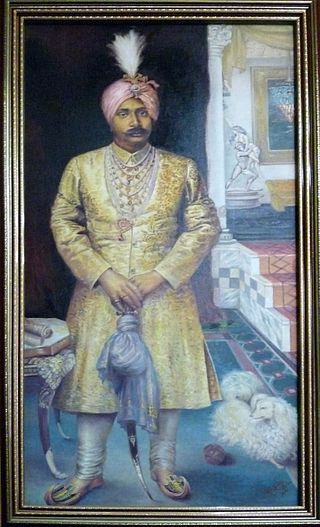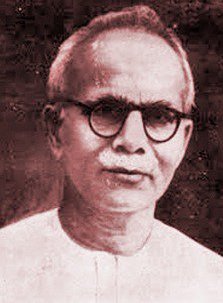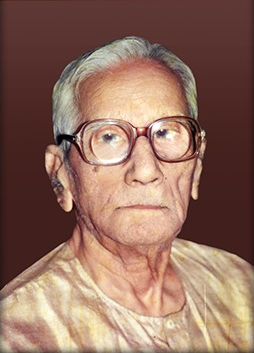
Odia is an Indo-Aryan language spoken in the Indian state of Odisha. It is the official language in Odisha, where native speakers make up 82% of the population, and it is also spoken in parts of West Bengal, Jharkhand, Andhra Pradesh and Chhattisgarh. Odia is one of the many official languages of India; it is the official language of Odisha and the second official language of Jharkhand.

Baripada is a city and a municipality in Mayurbhanj district in the state of Odisha, India. Located along the east bank of the Budhabalanga river, Baripada is the cultural centre of north Odisha. In recent years, it has emerged as an educational hub with the opening of numerous professional colleges.

Jayadeva, also spelt Jaideva, was a Sanskrit poet during the 12th century. He is most known for his epic poem Gita Govinda which concentrates on Krishna's love with the gopi, Radha, in a rite of spring. This poem, which presents the view that Radha is greater than Krishna, is considered an important text in the Bhakti movement of Hinduism.
The Madala Panji is a chronicle of the Jagannath Temple, Puri, Odisha, India. It describes the historical events of Odisha related to Lord Jagannath and the Jagannath Temple. The Madala Panji dates from the 12th century.

Gopabandhu Das (1877–1928), popularly known as Utkalamani Gopabandhu Das, was a social worker, reformer, political activist, journalist, poet and essayist.

Sarala Devi was an Indian independence activist, feminist, social activist, politician and writer. She was the first Odia woman to join the Non-cooperation movement in 1921 and the first Odia woman delegate of the Indian National Congress. She became the first woman to be elected to the Odisha Legislative Assembly on 1 April 1936.

The Odia cinema, colloquially known as Ollywood, is the Odia language Indian film industry, based in Bhubaneshwar and Cuttack in Odisha, India. The name Ollywood is a portmanteau of the words Odia and Hollywood.

Raj-Ranpur is a small town in the district of Nayagarh in the eastern Indian state of Odisha. The village is also known as Ranpurgarh or simply Ranpur as per the modern usage. The village is historically significant especially during the British Raj when it was the capital of the princely state of Ranpur. The martyrs Shaheed Raghu-Dibakar who were hanged for their resistance to British rule belong to this place. Rajsunakhala and Tang-Chandapur are the nearest Town of Raj- Ranpur, which in almost 14 & 10 km from the village. Rajsunakhala is the most important business Town in Ranpur block under Nayagarh district.

PanditBhikari Charan Bal, better known as Bhajan Samrat to the people of Odisha, was an Odissi music guru and singer, best known for his renditions of traditional Odia bhajanas, devotional songs addressed to the deity Jagannatha.

Jagabandhu Bidyadhara Mohapatra Bhramarbara Raya popularly known as Buxi Jagabandhu or Paika Khandayat Buxi was the commander (Buxi) of the forces of the king of Khurda. He is one of the earliest freedom fighters of India. The Paika rebellion in 1817 was under his leadership. The Buxi Jagabandhu Bidyadhar College in Bhubaneswar is named after him.

Jayakrushna Rajaguru Mohapatra popularly known as Jayi Rajaguru was a prominent figure of the Indian independence movement in the state of Odisha. A princely-priest by profession at the court of the Khurda kingdom, Rajaguru revolted against the British East India Company in the province. Whilst collaborating with the Marathas to recapture the British-controlled province, a Maratha messenger was caught by the British and Rajaguru's secret strategies got exposed. Upon failure of his removal from the king's court, a British force attacked the fort of Khurda and captured Rajaguru. He was later sentenced to death and executed in Baghitota, Midnapore.
Surendra Mohanty born in Odisha was an Indian author who wrote in Odia. He was the recipient of the Central Sahitya Academy Award for his novel Nilashaila.

Krushna Chandra Gajapati KCIE, also known as Captain Maharaja Sri Sri Sri Krushna Chandra Gajapati Narayana Deva KCIE, was a key personality and regarded as the architect, founding father of an Independent Odia Language speaking state Odisha. He was a scion of Paralakhemundi Estate and the owner of Delanga estate of Puri district of Odisha. His family belonged to the great Eastern Ganga Dynasty. He was the first Prime Minister of Orissa. The present-day Gajapati District of Odisha was named after him.

Pandit Godabarish Mishra was a poet and notable socialist from Odisha, India. He is known for his contribution to Odia literature.

Deula is an architectural element in a Hindu temple in the Kalinga architecture style of the Odishan temples in Eastern India. Sometimes the whole temple is also referred to as Deula. The word "deula" in Odia language means a building structure built with a particular style that is seen in most of the temples from Odisha. Deul is also used in English, though the deul temples are also of a different form in the Manbhum region of Western Bengal.

Pandit Nilakantha Das (1884-1967) was one of the most illustrious sons of Odisha, who appeared both in its political and literary arena at the most crucial period of its history, when Odisha had no political identity in the map of India, and Odia as a language was about to be extinct. He worked relentlessly for Odisha's recognition both politically and linguistically, and helped bring to fruition the dreams of Utkala Gaurab Madhusudan Das, Utkalamani Gopabandhu Das and all other Odia loving people.

Dr. Radhanath Rath was a newspaper editor, freedom fighter, social worker and politician from Odisha. He was the editor of The Samaja, one of the leading newspapers of Odisha.
Bidhu Bhusan Das, also spelled Bidhubhusan Das, was a public intellectual, educator, professor, senior government official, and university president/Vice Chancellor from India.

Satyavadi Vana Vidyalaya is an Indian school in Sakhigopal, Odisha. It is a pre-secondary and Secondary school, located at Sakhigopal a part of Puri district, in the Indian state of Odisha. It was established by renowned writer and social worker Utkalamani Gopabandhu Das in 1909.

Parlakhemundi estate was a Zamindari of Odisha in the British Raj period .Before odisha province formation it was under Madras Presidency.The state was ruled as an independent kingdom till 1769.The royal family belong to the Krishnatreya gotra Odia Kshatriya and traced their lineage to Eastern Ganga Dynasty.It was a zamindari estate lying in the southwestern portion of Ganjam district, covering an area of 615 square miles. It was bounded in the south by the district of Vizagpatnam and on the west by the Jeypore Estate and the tribal agencies of the Eastern Ghats.

















